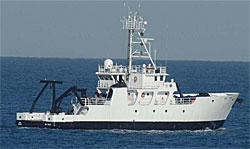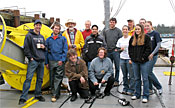You are here
Multi-platform Research Campaign Sets Sail in May
The center is performing a multi-platform research campaign during the spring thaw in the Columbia River. Three research vessels and two mobile platforms are operating simultaneously to accomplish a diverse set of science objectives. 
Date: May 12-30, 2009
Chief Scientist: Byron Crump
Research Vessel: R/V New Horizon
Web: Cruise Web Page
SCIENTIFIC OBJECTIVES 1. CTD casts and sensor-based measurements. 2. Water sampling. 3. Surface flow-through system. 4. Dye Studies. 5. Plume Feature Tracking. 6. SATURN station calibration. 7. Estuary ETM sampling.
 Date: May 13-26, 2009
Date: May 13-26, 2009
Chief Scientist: Murray Levine
Research Vessel: R/V Point Sur
Data: Flowthrough, cast, and model comparisons
Web: Cruise Web Page
SCIENTIFIC OBJECTIVES 1. Survey of Columbia River plume 2. Dye studies (coordinated with R/V New Horizon) 3. Plume Feature Tracking and Salt Wedge Tracking 4. Estuarine Turbidity Maxima (ETM)-1 and ETM-2 studies (coordinated with R/V New Horizon)
 Date: May 11-25, 2009
Date: May 11-25, 2009
Mission Leader: Katie Rathmell
Vessel: R/V Forerunner
Mobile Platform: Glider
Web: Glider Status
SCIENTIFIC OBJECTIVES The glider will be tested outside the Columbia entrance on Monday, if all goes well we will release the glider to travel, on its own, north to the Grays Harbor line (47 degrees N) where it will spend two weeks oscillating from 10 nm to 60nm across the continental shelf, whilst see-sawing from the surface to 200m deep. To avoid any potential conflict the line transversed will be 0.5nm south of the Grays Harbor line so research ships using the same standard line will not interact with it. After that time it will be commanded to head back towards the Columbia entrance for recovery.
 Date: May 13-14, 2009
Date: May 13-14, 2009
Chief Scientist: Craig McNeil
Vessel: R/V Forerunner
Mobile Platform: Autonomous Underwater Vehicle
SCIENTIFIC OBJECTIVES 1. Study mixing of the Columbia River plume and subsequent generation of internal waves at the advancing plume front. 2. Study propagation of internal waves in the Columbia River estuary in the North channel using coordinated REMUS sampling with the radar system mounted on the Astoria Bridge (PI Bill Plant, APL/UW). 3. Estimates of net community productivity and indicators of carbon cycling within the estuary and plume. We are interested in biogeochemical cycling of dissolved gases, including O2, N2, CO2.




